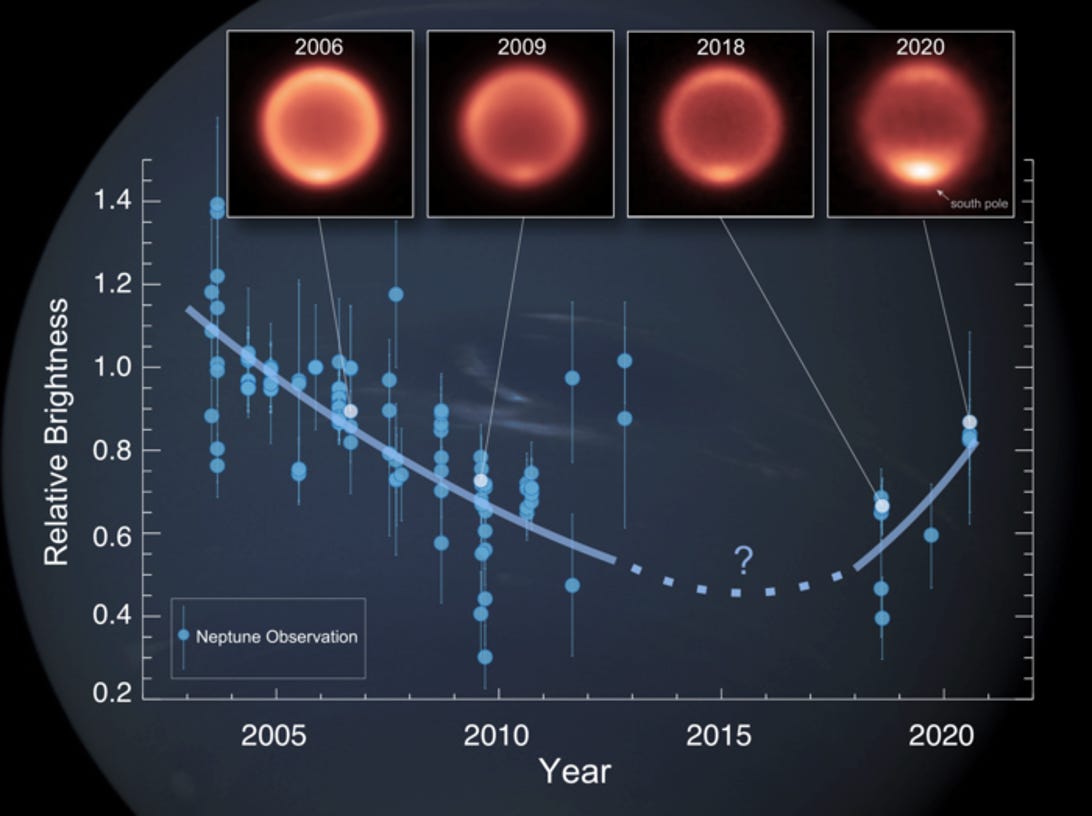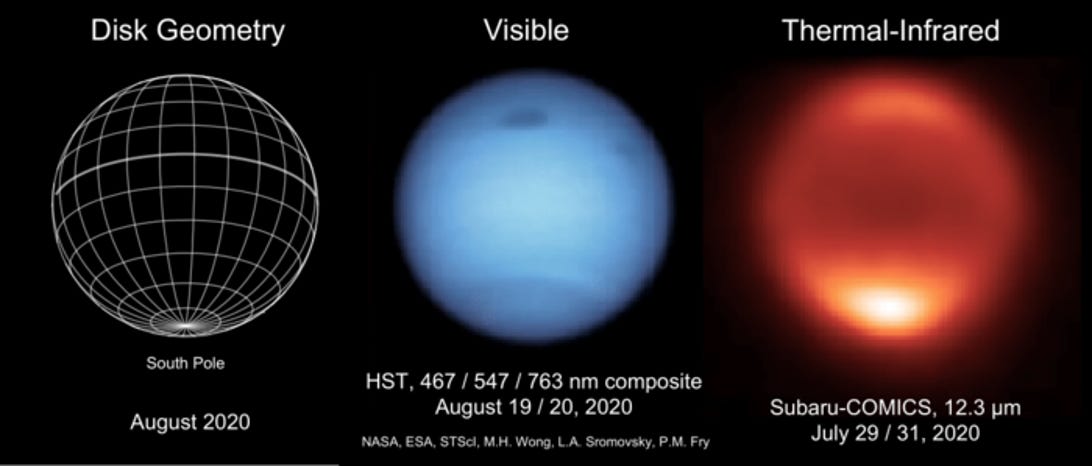

Voyager 2 view of Neptune, captured in August 1989.
NASA/JPL-Caltech/Kevin M. Gill
Some 2.7 billion miles from Earth, the south aspect of Neptune is in the course of summer time. However it is not the type of summer time we are used to.
Neptune takes round 165 Earth years to complete an orbit across the solar, this means that its seasons every dawdle on for 40 such years. That is about 160 occasions longer than considered one of our seasons, and consistent with new analysis printed Monday within the magazine Planetary Science, this is not even the strangest phase.
In contrast to our house planet — which heats up in the summer for picnic days and seaside escapades — the azure international appears to be… cooling down?
“This transformation was once sudden,” Michel Roman, a researcher on the College of Leicester and lead writer of the find out about, mentioned in a observation. “Since we have now been watching Neptune all the way through its early southern summer time, we might be expecting temperatures to be slowly rising hotter, now not chillier.”
The unexpected in finding comes after a world workforce of researchers mixed 20 years’ value of infrared photographs depicting Neptune, amassed by means of tremendous tough telescopes just like the Ecu Southern Observatory’s Very Massive Telescope. Principally, those photographs can inform what the planet’s thermal prerequisites are according to how brilliant it’s. Brighter manner warmer.
After testing the datasets, the workforce obviously discovered Neptune’s thermal brightness declining in its stratosphere between 2003 and 2018, all the way through the planet’s first whispers of summer time. Put in combination, that provides as much as a more or less 8 levels Celsius drop in temperature, the find out about says.

The plot presentations the relative exchange within the thermal-infrared brightness from Neptune’s stratosphere with time for all present photographs taken by means of ground-based telescopes. Brighter photographs are interpreted as hotter.
Michael Roman/NASA/JPL/Voyager-ISS/Justin Cowart
However this is the place issues get even more odd.
Down on the south pole of Neptune, the researchers noticed the planet warming between 2018 and 2020, one thing they are saying has never been observed ahead of on the windy orb’s poles. (I say windy, as a result of Neptune’s winds are so totally rapid they are thought to be supersonic, aka sooner than the rate of sound). “Our information covers lower than part of a Neptune season, so nobody was once anticipating to look massive and fast adjustments,” Roman mentioned.

Neptune as observed in visual gentle (heart) and thermal-infrared wavelengths (proper), in 2020. Within the thermal-infrared, Neptune’s heat south pole glows extra brightly than ever observed ahead of.
Michael Roman/NASA/ESA/STSci/M.H. Wong/L.A. Sromovsky/P.M. Fry
Alternatively, Roman does be offering a couple of concepts for Neptune’s summertime temperature confusion.
“Temperature permutations could also be associated with seasonal adjustments in Neptune’s atmospheric chemistry, which is able to regulate how successfully the ambience cools,” Roman mentioned. “However random variability in climate patterns, or perhaps a reaction to the 11-year sun task cycle may additionally have an impact.”
In different phrases, it is imaginable that Neptune’s thermal shenanigans may just technically be taking place as a result of sheer accident, periodic variation within the solar’s task and even adjustments surrounding our host superstar’s sunspots, the place magnetic fields are unimaginably robust – like, over 2,000 occasions that of Earth’s.
The researchers additionally recommend common stratospheric adjustments, or possibly simply the selection of brilliant clouds floating round Neptune may have made the blue gasoline massive’s thermal brightness regulate swiftly. However for now, those suggestions are all very theoretical.
Although excitingly, such hypothesis might quickly be put to leisure as a result of… drum roll please… the lately introduced James Webb Area Telescope. It has precisely what we want in our arsenal to decode Neptune’s seasonal fact. It is crammed to the brim with infrared imaging apparatus actual and powerful sufficient to look into the private, darkest, maximum elusive areas of house.

This artist’s thought presentations the James Webb Area Telescope.
NASA
“The beautiful sensitivity of the gap telescope’s mid-infrared software, MIRI, will supply unparalleled new maps of the chemistry and temperatures in Neptune’s surroundings, serving to to raised determine the character of those fresh adjustments,” Leigh Fletcher, a planetary scientist on the College of Leicester and co-author of the find out about, mentioned in a observation.
Time for us so as to add but some other superior puzzle to Webb’s often compounding job listing that already contains learning such things as the farthest superstar we now have ever detected and exploring new avenues in pursuit of discovering alien existence.
Get the CNET Now newsletter
Spice up your small talk with the latest tech news, products and reviews. Delivered on weekdays.
